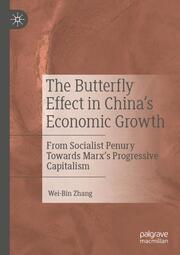Detailansicht
The Butterfly Effect in Chinas Economic Growth
From Socialist Penury Towards Marxs Progressive Capitalism
ISBN/EAN: 9789811598913
Umbreit-Nr.: 3034517
Sprache:
Englisch
Umfang: xvii, 213 S., 5 s/w Illustr., 13 farbige Illustr.,
Format in cm:
Einband:
kartoniertes Buch
Erschienen am 25.11.2021
Auflage: 1/2021
- Zusatztext
- This book examines the butterfly effect in China's modern economic development during the period of 1978-2018. In chaos theory, the butterfly effect refers to a phenomenon that a butterfly flaps its wings in Okinawa, and subsequently a storm may ravage New York. Deng applied a trivial idea, called the market mechanism, to China's countryside in 1978. The idea has subsequently caused economic structural changes and fast growth in the economy with the largest population in human history. China's per capita GDP jumped from $100 in 1978 to over US$8,000 in 2018. Eight hundred million people have made a great escape from poverty. By 2018, China was the world's second-largest economy from its 10th position in 1978 with its 9 per cent average annual growth rate of GDP in the previous four decades. This illuminating book will be of value to economists, scholars of China, and historians.
- Kurztext
- This book examines the butterfly effect in China's modern economic development during the period of 1978-2018. In chaos theory, the butterfly effect refers to a phenomenon that a butterfly flaps its wings in Okinawa, and subsequently a storm may ravage New York. Deng applied a trivial idea, called the market mechanism, to China's countryside in 1978. The idea has subsequently caused economic structural changes and fast growth in the economy with the largest population in human history. China's per capita GDP jumped from $100 in 1978 to over US$8,000 in 2018. Eight hundred million people have made a great escape from poverty. By 2018, China was the world's second-largest economy from its 10th position in 1978 with its 9 per cent average annual growth rate of GDP in the previous four decades. This illuminating book will be of value to economists, scholars of China, and historians. WeiBin Zhang, Ph.D. (Umeå, Sweden), is Professor of Economics in Ritsumeikan Asia Pacific University (APU), Japan. He was graduated in 1982 from the Department of Geography, Beijing University, China. He completed graduate study at the Department of Civil Engineering, Kyoto University, Japan. After he completed his dissertation on economic growth theory, he researched at the Swedish Institute for Futures Studies in Stockholm for 10 years. During the Swedish period, he also worked as visiting scholars in USA, Japan, Mainland China, Austria, and Hong Kong. He taught at the Department of Economics, NUS, until May 2000, for one and half years, after he had been appointed as Tenured Professor at APU in 1998. His main research fields are nonlinear economic dynamics, growth theory, trade theory, East Asian economic development, and Confucianism. He has singleauthorized about 360 academic articles (240 in peerreview international journals) and authorized 23 academic books in English by international publishing houses. Prof. Zhang is one of the editorial board members of 15 international journals.
- Autorenportrait
- Wei-Bin Zhang, Ph.D. (Umeå, Sweden), is Professor of Economics in Ritsumeikan Asia Pacific University (APU), Japan. His main research fields are nonlinear economic dynamics, growth theory, trade theory, East Asian economic development, and Confucianism. He has single-authorized about 360 academic articles (240 in peer-review international journals) and authorized 23 academic books in English by international publishing houses. Prof. Zhang is one of the editorial board members of 15 international journals.
